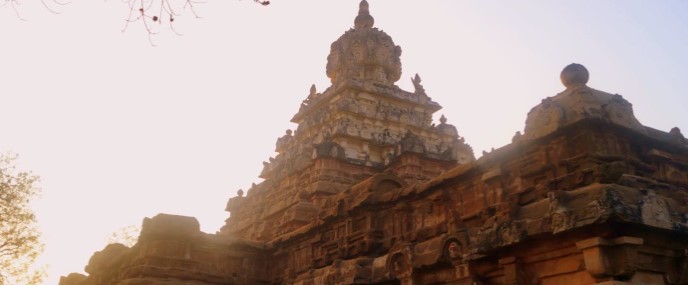There were no voters in this electoral system, and people from all castes could not contest in this form of a so-called democratic system.

Uthiramerur temple. Copyright Tourism Ministry, India
The famed Kudavolai electoral system of the Chola Kings and early Tamils followed is much touted as an arcane form of democracy.
Even Prime Minister Narendra Modi drew a parallel between the rules for modern-day elections and the Kudavolai system during the foundation-laying ceremony of the new parliament building in 2020. Modi mentioned the same during a “Mann Ki Baat” in January 2023.
The Tamil Nadu government’s tableaux depicting the Kudavolai system for the Republic Day Parade 2024 won third prize.
Do you know that there were no voters in this electoral system, and people from all castes could not contest in this form of a so-called democratic system?
With the polling for the Lok Sabha elections only days away, South First brings you some facts and myths about the Kudavolai system.
In Tamil, “Kudam” means “pot”, and “Olai” means “palm leaf”. The Kudavolai system is an electoral system followed in the Brahmadeya villages of ancient Tamil Nadu.
In this system, the contestants’ names for membership of the ‘Maha Sabhas’ were written on palm leaves, and the winner was selected by a lucky lot, drawn in front of the entire village by a Brahmin boy. There were contestants but no electors in this system.
Separate boards governed education, trade, village maintenance, temple maintenance, agriculture, etc, and these boards of the respective Brahmadeya villages were elected through the Kudavolai system.
Brahmins were given exclusive residential rights in Brahmadeya villages. The residents of these villages were exempt from paying any form of tax to the kingdoms. Rules that also dealt with crime and punishment did not apply here.
The Kudavolai election system was reportedly practised much before the 10th century CE. However, concrete proof of its existence can only be traced to 917 CE and 919 CE.
The inscriptions at the Vaishnavite temple of Shri Vaikunda Perumal temple at Uthiramerur in Kanchipuram district of Tamil Nadu are considered the earliest proofs of the existence of the Kudavolai system.
Uthiramerur, also known as Uthiramerur Chaturvedi Mangalam, selected administrators of various boards for its 30 Kudumbus and 12 Cheris. Kudumbu is the equivalent of a present-day “ward”, and Cheri denotes a place where the people of a specific community live.
Engravings about the Kudavolai system, similar to the Uthiramerur inscriptions, were also found at Chandralekai (present-day Senthalai) in Thanjavur district and Manor in Tirunelveli district. The system was in vogue in Manor under the Pandya rule.
Though historians state that the Pallava King Nandivarman II gave away the land to the Brahmin community as early as the 8th century to establish a Brahmadeya village at Uthiramerur, the Kudavolai system is mentioned only in the inscriptions from the 12th and 14th years (917 CE and 919 CE, respectively) of the rule of Paranthaka Chola I.
The qualifications of the candidates are mentioned in these two inscriptions.
The first inscription, from 917 CE, states that the contestant should own one-fourth “veli” of land, reside at his own place, be aged between 30 and 60, morally earn wealth, have a good soul, and specialise in matters related to the Vedas and Shastras. Those who have been members of any board in the past three years and their family members are barred from the contest.
“If one has to be a scholar in Vedas and Shastras, then the person should be a Brahmin male. Others were not allowed to learn Vedas and Shastras. So, in effect, only Brahmin males could become members of these boards.”
“People from other communities also lived in the areas controlled by these boards. However, they could not participate in the Kudavolai system. Then how can it be called a democratic election system?” asks retired professor and historian A Karunananthan.
The second inscription from 919 CE lists a few more qualifications. According to the second inscription, past board members who defaulted on public accounts and their family members were also barred.
Those who acted against Ahamas (rules to establish and govern temples), murderers, and incest practitioners could not contest. Those who misappropriated others’ properties and acted against the public interest and their family members could also not contest. The age criterion has been changed from 35 to 70 this time.
This inscription relaxes the land-owning criteria from one-fourth veli to one-eighth veli. The condition is that the person is well-versed in one Veda and four Bashyams. This indirectly cements the ‘Brahmin male only’ entry.
Karunananthan sys Dalits and Bahujans could not participate in the process, though they lived under the boards’ jurisdiction. Furthermore, members of the boards were selected through the Kudavolai system.
“These boards were like a ‘government within a government’ so that the kingdom’s laws could not control the Brahmins. The Kudavolai system is one in which nobody can vote, and not everybody can contest. Terming it as an ancient form of democracy is very worrying,” he says.
Contents of the Uthiramerur inscriptions shed light on local governance, administration, rules barring wrongdoers from contesting, etc. However, there is no consensus that the Kudavolai system is a democratic electoral process.

Apr 15, 2024

Feb 28, 2024

Oct 20, 2023

Apr 11, 2023

Apr 03, 2023

Oct 13, 2022